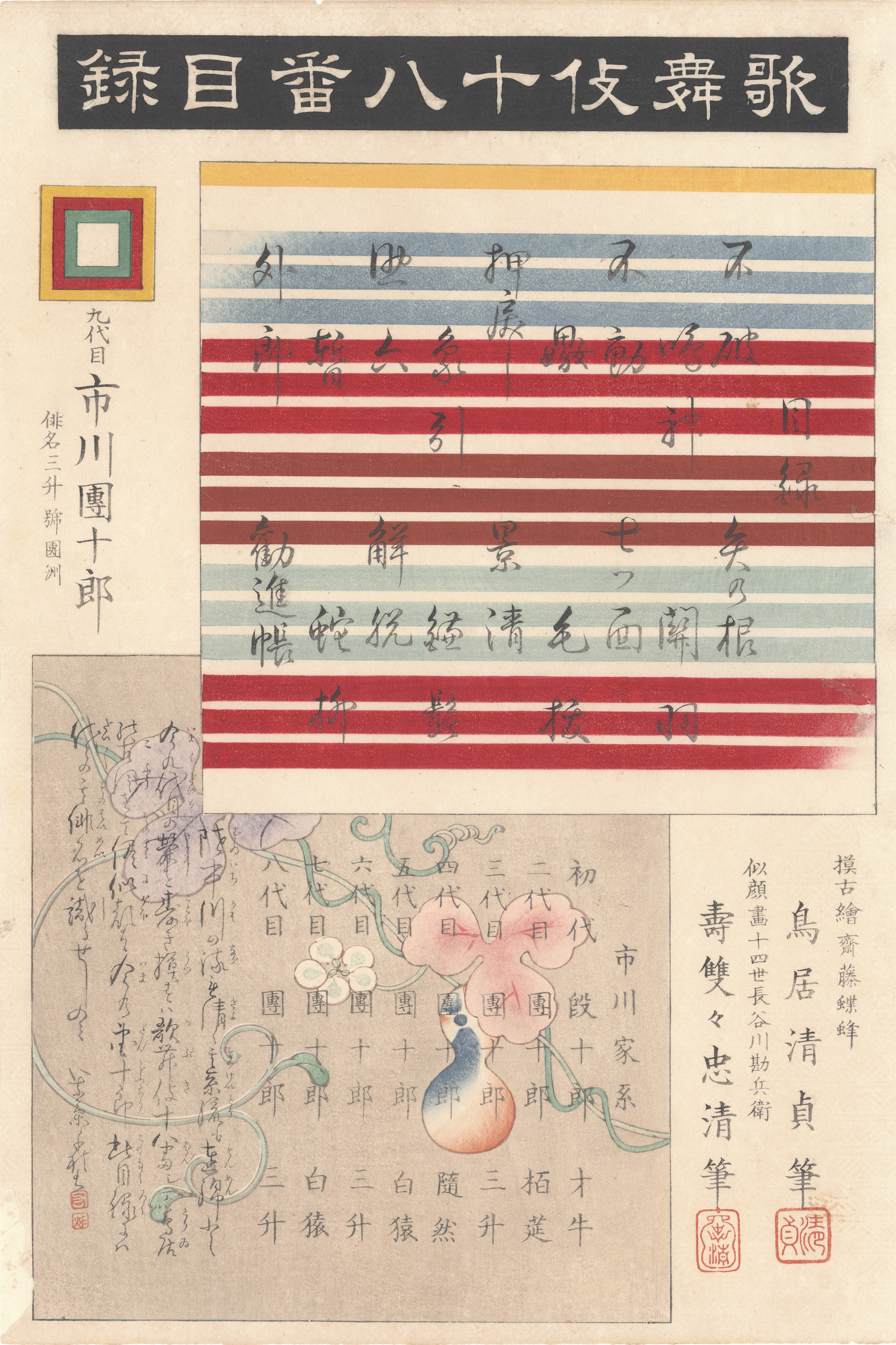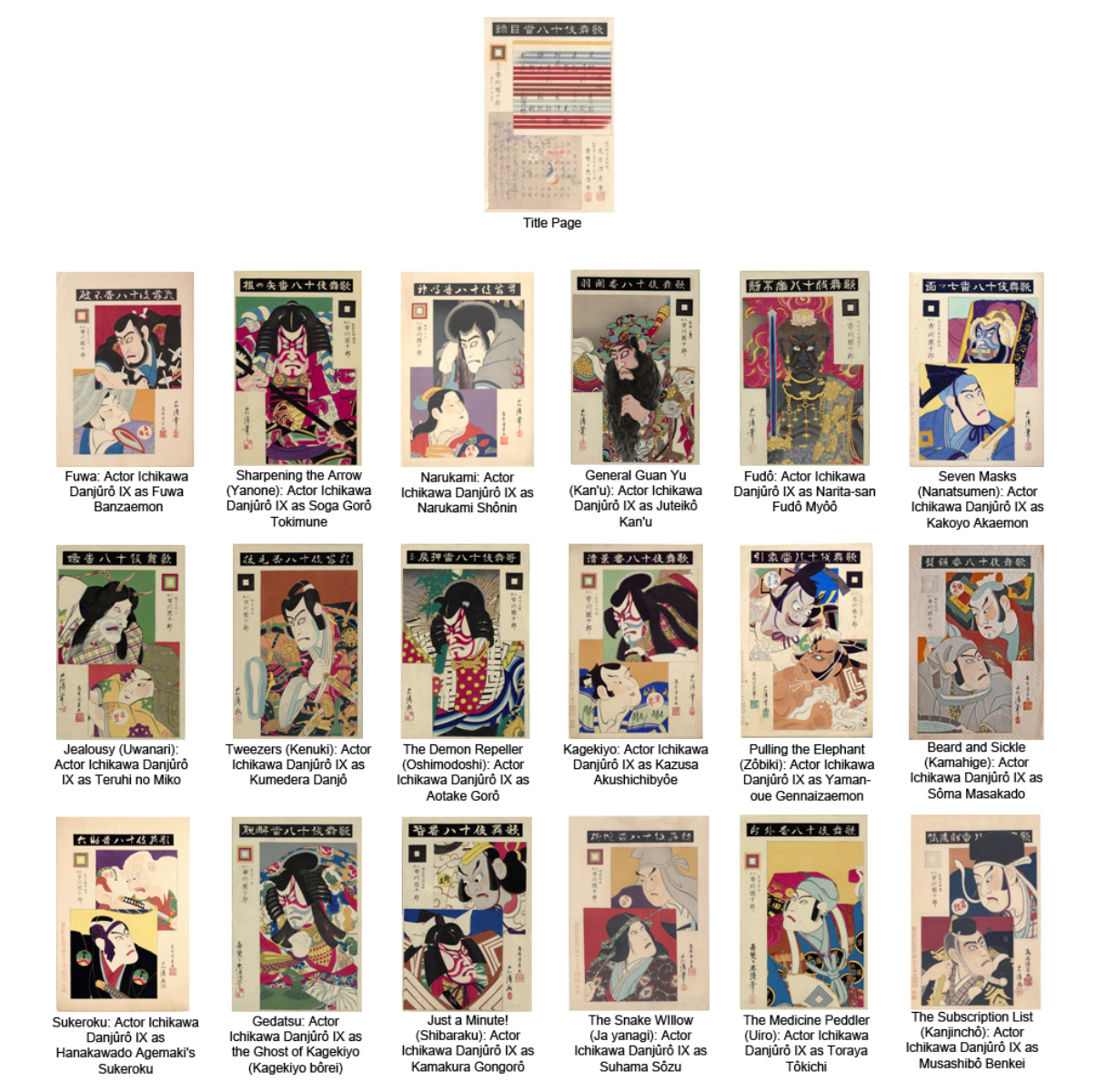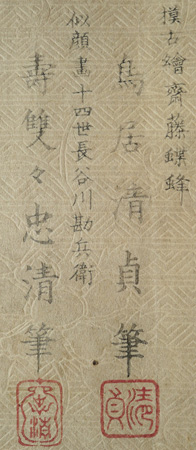About This Print
Title page and index (mokuroku 目録) for the series The Kabuki Eighteen. These eighteen plays were selected by Ichikawa Ebizō V (Ichikawa Danjūrō VII) in 1840 as the most representative aragoto (rough-stuff) plays of the Ichikawa Danjûrô line of actors.The upper right square with the multi-colored bands contains the names of all eighteen plays, as follows (reading from right to left):
目録 (index): 不破 (Fuwa), 矢の根 (Yanone), 鳴神 (Narukami), 関羽 (Kan'u), 不動 (Fūdō), 七ツ面 (Nanatsumen), 嫐 (Uwanari), 毛抜 (Kenuki), 押戻し (Oshimodoshi), 景清 (Kagekiyo), 象引 (Zohiki), 鎌髭 (Kamahige), 助六 (Sukeroku), 解脱 (Gedatsu), 暫 (Shibaraku), 蛇柳 (Jayanagi), 外郎 (Uirō Uri), 勧進帳 (Kanjinchō)
Below the play titles is a listing of the first eight actors in the Ichikawa family lineage. The generational number is given, followed by the Danjūrō name, followed by the particular Danjūrō's poetry name. (The poetry names usually linked to the stage name Danjūrō were Sanshō and Hakuen.) Reading from right to left we see:
市川家系 (Ichikawa family lineage): 初代 段十郎 才牛 (founder Danjūrō - Saigyū), 二代目 団十郎 柏莚 (2nd generation Danjūrō - Hakuen), 三代目 団十郎 三升 (3rd generation Danjūrō - Sanshō), 四代目 団十郎 隨然, (4th generation Danjūrō - Zuinen*), 五代目団十郎 白猿 (5th generation Danjūrō - Hakuen), 六 代目 団十郎 三升 (6th generation Danjūrō - Sanshō), 七代目 団十郎 白猿 (7th generation Danjūrō - Hakuen), 八代目 団十郎 三升 (8th generation Danjūrō - Sanshō)
To the left of the titles of the play we see the Ichikawa mon (family crest) of a mimasu (triple rice measure), followed by then (December 1895) current Danjūrō's generation 九代目 (9th generation) and name 市川 團十郎 (Ichikawa Danjūrō) followed by the characters 俳名三升號団洲 (俳名 poetry name, 三升 Sanshō followed by 號団洲 Danshū.)
*In this case Danjūrō IV's Buddhist name of Zuinen is given.
About The Series (1895-1896 Release and 1927 Release)
Torii Kiyotada’s most famous works are his 1895-1896 series of actor prints created with his father Torii Kiyosada titled Kabuki juhachiban (The Kabuki Eighteen) and published by Hasegawa Sumi . The series illustrates characters in each of eighteen plays selected by Ichikawa Ebizō V (Ichikawa Danjūrō VII) in 1840 as the most representative aragoto (rough-stuff) plays of the Ichikawa Danjūrō line of actors.1 Lawrence Smith writes that "The portfolio seems to have been designed by Kiyotada using original sketches by his father Kiyosada, who was a contemporary of Danjūrō."2
The series was re-printed and published again in 1927 by the publisher Shūbisha. Shūbisha issued the series in nine sets of two prints each, enclosed in an envelope. These re-issued prints lack the original publisher's name and related information that appeared in the left column on the original Hasegawa release.
The Entire Series - The Kabuki Eighteen (Kabuki Jūhachiban)
Print Details
| IHL Catalog | #721 |
| Title or Description | Title page 目録 |
| Series | The Kabuki Eighteen (Kabuki Jūhachiban) 歌舞伎十八番 |
| Artist | Torii Kiyosada (1844-1901) and Torii Kiyotada VII (1875-1941) |
| Signature | from right to left: Mo-ko-é Saitō Chō ho 模古繪斎藤蝶蜂 Torii Kiyosada hitsu 鳥居清貞筆 followed by Kiyosada seal Nigao-é Juyon sei Hasegawa Kambei 似顔畫十四 世長谷川勘兵衛 Jusōsō Tadakiyo hitsu 寿雙々忠清筆 followed by Tadakiyo seal |
| Seal | Kiyosada seal right - Tadakiyo seal left |
| Publication Date | December 30, 1895 (Meiji 28) 明治廾八年十二月三十日 |
| Publisher | 長谷川寿美 Hasegawa Sumi [Marks: seal 25-406 長谷川寿美; publisher ref. 102] |
| Engraver | 彫工弥太 Horikō Yata |
| Impression | good |
| Colors | good |
| Condition | good - not backed; light soiling throughout; some trimming of margins including removal of publishing information in left margin; paper loss lower left corner repaired verso. |
| Genre | ukiyo-e; yakusha-e |
| Miscellaneous | embossing throughout |
| Format | vertical oban |
| H x W Paper | 14 1/4 x 9 3/8 in. (36.2 x 23.8 cm) |
| Literature | |
| Collections This Print | Museum of Fine Arts, Boston RES.53.1; Tokyo Metropolitan Library 5721-C008-01; Tsubouchi Memorial Theatre Museum of Waseda University 201-0124 and 201-0143 and 201-0163 |





